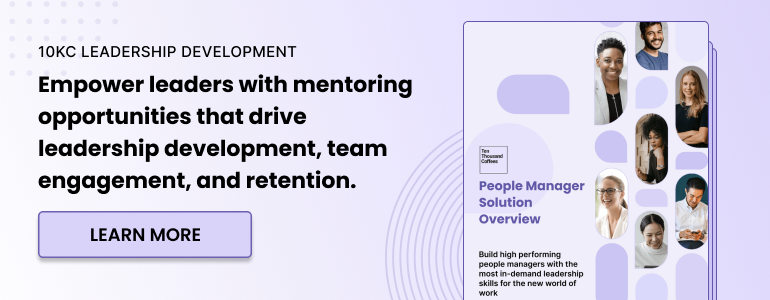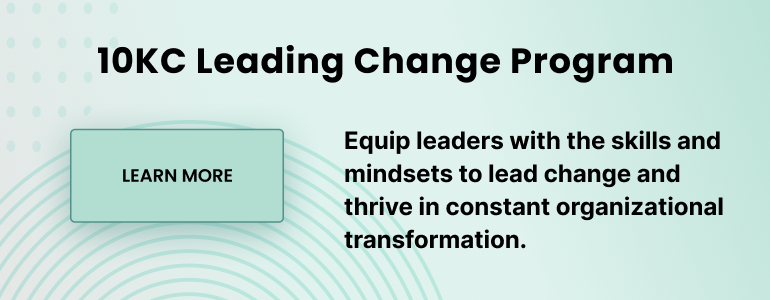Organizations around the world spent over $357 billion on leadership development and corporate training programs in 2020 alone, even amidst the pandemic, And 57% of L&D professionals say leadership and management are the highest priority skills for their organization.
It’s clear that leadership development isn’t being neglected.
Yet at the same time, almost two-thirds (63%) of millennials feel that their employers are not fully developing their leadership skills.
So, it begs the question: why aren’t leadership programs living up to our expectations or delivering the results?
The truth is that simply putting a training program in place just isn’t enough. Organizations need to create opportunities for the right individuals and invest in structured programs that bring employees and employers closer to their leadership goals.
Keep reading as we break down why having the right leadership program matters. We’ll also share some steps for investing in a development strategy that will help you successfully level up leaders within your organization.
Leadership development: Definition
Leadership development is the process of strengthening the leadership skills of existing and potential leaders within your organization.
Companies might invest in leadership development for a few different reasons. One of which is helping current organizational leaders and people managers thrive in order to boost the overall effectiveness of your leadership team. Another is upskilling high-potential future leaders, so they’re ready to lead teams when the time comes.
Leadership training and development can look different depending on your goals and the employees involved. You’ll often see leadership training programs, but leadership development strategies can—and should—also include mentorship opportunities and experiential learning (such as stretch projects) that allow leaders to truly expand their skills.
What’s involved with leadership training for employees?
Helping employees build their leadership skills is just the tip of the iceberg when it comes to leadership training. The key to long-term impact? Strategic leadership development that goes beyond skills and competencies.

An effective leadership training strategy involves:
- Filling internal leadership pipelines: 77% of organizations report having a leadership gap. This might sound surprising until we realize that only 5% of companies have leadership training across all employment levels. When leadership development solely focuses on existing leaders, organizations can struggle to find the right folks to fill the leadership table as senior leaders leave the company. Promoting internally is a talent pipeline strategy that also allows companies to also maintain continuity and institutional knowledge within the organization.
- Improving diversity across leadership roles: Underrepresented and diverse employees are often overlooked for senior leadership positions. For example, women still make up only 28% of C-suite and executive board roles. While sometimes diversity gaps are a result of discrimination, it can often simply be because these groups haven't been provided with the same development opportunities as the rest of their peers. Leadership training strategies and sponsorship programs help elevate underrepresented employees so they can become effective leaders.
- Boosting employee engagement: Only 36% of employees feel their leadership is supporting them in a way that makes them feel engaged in the workplace. And just 15% of leaders feel prepared to address and prevent employee burnout. The right leadership development curriculums make for a better workplace for everyone. They not only empower leaders to better support their teams but also help engage employees directly.
- Attracting leaders and other top talent: In a perfect world, companies would be able to fill all roles internally. But this isn’t always possible. 62% of employees would leave their companies for one with more mentorship, development, and connectivity opportunities. Companies that provide opportunities for leadership growth and development are more likely to attract the right candidates when they need to fill open roles externally.
- Equipping leaders for change management: In a work landscape continuously reshaped by business transformations, restructures, and the AI revolution, staying ahead is increasingly challenging for leaders. It's critical to arm them with the necessary skills and mindsets to navigate and lead effectively through constant organizational change.

How to identify and develop emerging leaders
The vast majority (58%) of employees would leave their current company if they didn’t have access to career advancement and development opportunities.
While employee turnover is never ideal, the impact of losing top talent can be even more costly. Losing a high-potential employee can cost organizations up to 3.5x their annual salary, and that’s before we even consider the lost work productivity and expertise.
This is why it’s critical to identify emerging leaders early on, so you can provide them with development opportunities that enable them to become leaders when the time comes. Investing in these employees is also a simple way to show you have a vested interest in your employees’ long-term growth and career path, which can boost retention and engagement.
Of course, if you identify the right employees, they’re also the ones who are most likely to provide the largest return on your development investment. However, with rapidly changing business needs, identifying future leaders and high-performers can be challenging.
Here are a few ways you can narrow down the emerging leaders in your organization:
1. Review performance
One of the simplest ways to identify high-performing employees is by looking at their performance and quality of work. Who consistently exceeds expectations? What performance metrics are they hitting? Have they demonstrated the qualities of a successful leader?
It’s worth noting that emerging leaders aren’t necessarily always employees who have already demonstrated leadership skills. They simply need to show signs that they can become effective leaders. For example, they might be strong communicators and take initiative. Or they may even have a tendency to take on a leadership role among their peers.
2. Speak to their managers
Talent teams and program managers should be responsible for implementing leadership development strategies. But when it comes to identifying the right folks for the program, it’s also worth speaking with the people they work with every day—their managers.
Managers have a front-row seat to everyone on their team. They can observe employee behavior as they interact with colleagues, how they manage feedback, and even their long-term goals. This provides additional insight into leadership potential that may not come across clearly in performance reviews.
3. Understand their career goals
Before investing in an employee’s leadership development, it’s worth understanding where they see themselves in the future.
The reality is that not all employees strive to become people managers or leaders. There are many that prefer to excel in their specific job functions as individual contributors. This doesn't mean that they won’t be an asset to your organization’s future, but it does mean that they may not be the best candidate for your leadership development program.
Emerging leaders have the skills and career aspirations that align with your organization’s leadership needs.
Remember: while leadership development may not be the right path for individuals who don’t fall into this category, their work is still important to your company. Make sure you’re investing in other opportunities for growth and development. Otherwise, your leaders might find themselves leading a team of individual contributors who are disengaged and unmotivated.
4. Offer the right leadership development opportunities
When we think about employee development, companies often jump straight to training programs.
Don’t get us wrong—there’s a ton of value in more traditional training.
However, we also know that the majority of employee development comes from peer learning and experiential opportunities. This is why the best leadership growth strategies tend to have multiple components that help employees and employers make the most of their development experience.

Creating a leadership development strategy for your organization
Putting together a successful leadership development strategy involves several moving pieces. But it’s certainly possible to put together a program that employees love and also delivers results.
Here are a few steps you can use to guide you through planning and executing your organization’s leadership development strategy.
1. Define leadership for your company
First, you need to define leadership in your organization. There are a few questions you want to answer:
- Who is a leader? Sure, technically a leader is anyone who leads a group of people. But when it comes to a development program, identifying the right people is a critical first step. For example, this could include all people managers, senior leadership, or even just high-performers who are on track to leadership roles.
- What does a successful leader look like? What are the skills and competencies that would make a leader successful within your company? And how can you build those skills?
2. Set goals and development objectives
Before you rush into implementation, you need to outline the outcomes that are important to your organization and your stakeholders. Are you looking to boost retention? Do you have diversity targets? Or is there a leadership gap that needs to be filled?
This stage helps you identify where you need to focus your efforts, so you can develop curriculums that align with your goals. And since leadership development is an investment, knowing which metrics to track makes it much easier to communicate ROI to stakeholders and senior management.
3. Develop a structured curriculum
Without a structured curriculum that’s tailored to your leadership needs, it’s easy to find yourself grasping at straws. You may see some progress, but it limits your ability to make an impact in the areas that truly matter.
Curriculums can also keep employees engaged and make the most of their program experience, as it provides a roadmap for their development.
In a leadership program, a curriculum or development program should include:
- Mentorship and networking opportunities: Learning should never happen in a silo. Your leadership curriculum should provide ways for employees to learn from their peers and other senior leaders.
- Expert toolkits and resources: Provide tactical support and frameworks that leaders can use to be more effective in their roles.
- Critical skills: Opportunities to build key skills that will make them better leaders and contributors, including emotional intelligence, stress management, change management, allyship, and beyond.

4. Expand networks for emerging leaders
Employee networks are key to employee development and creating opportunities for growth. And by nature, leadership requires employees to be effective communicators and collaborate within a community.
That’s why the best leadership development programs are community-driven. This means creating opportunities for employees to connect with executives and peers across the organization. This can include fostering mentorship relationships with senior executives, sponsorship programs, or even recreating water-cooler conversations virtually.
The goal is to improve visibility and intentionally create ways to strengthen the professional networks of existing and potential leaders.
5. Build effective mentor and mentee matches
There are many ways to approach a successful leadership development strategy, but mentorship should be a top priority. However, effective mentorship relies on matching potential leaders with the right mentors.
Fortunately, making mentorship matches at scale doesn’t need to be complicated. Mentorship software, like 10KC, is carefully designed to help mentorship program managers bring the right people together. (Without having to filter through a stressful spreadsheet.)
10KC’s algorithm matches employees based on shared goals and interests with just a click of a button, while curriculums and conversation guides provide impactful guidance. Future leaders can learn from the people who can guide and support them best.
6. Track and measure progress
Successfully launching a leadership development program is just the beginning.
It’s time to track your progress towards those goals you set. It’s the only way to make sure that your carefully implemented leadership development program is providing the intended results.
How to measure the success of a leadership development plan
Like any business initiative, you should be measuring the success of your leadership development program—not just post-program but throughout the program as well. This highlights areas of growth and allows you to quickly identify areas of improvement to make adjustments and improve results along the way.
There are a number of ways to measure success in leadership development:
- Program participation and completion: Are participants finding enough value in it to complete the entire program? Where’s the biggest drop off?
- Internal mobility: This is the rate at which participating employees are moving into leadership roles. Are leaders in the program being promoted and progressing in their careers?
- Employee feedback: Both from participants, as well as their managers and direct reports. Is there a positive change as a result of the leadership development?
- Skills development: Are participants showing signs of improvement in the skills that you’ve targeted in your leadership development curriculum?
- Employee engagement: Does the leadership development plan have a positive impact on both the engagement of all employees, as well as within leaders themselves?
The best way to keep track of your progress? By bringing employee surveys and real-time program data into data dashboards.
Boost your leadership development program with 10KC
Leading enterprises trust 10KC to deploy, manage, scale, and measure leadership development programs. Get access to off-the-shelf programs and mentorship experiences that allow your organization to get the most of the development experience.
Most importantly? 10KC integrates directly with the tools that your leaders work with every day so they can spend more time growing and less time figuring out how to use yet another platform.










.png)